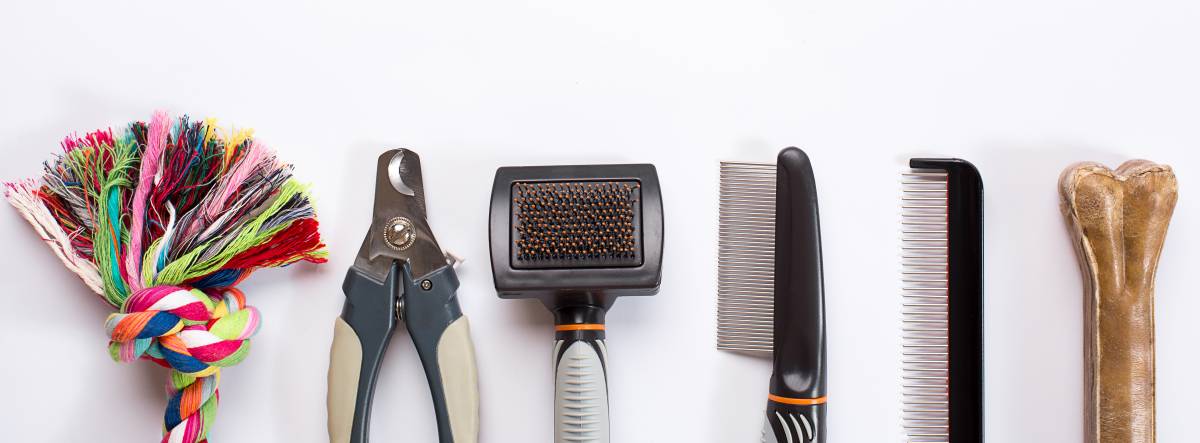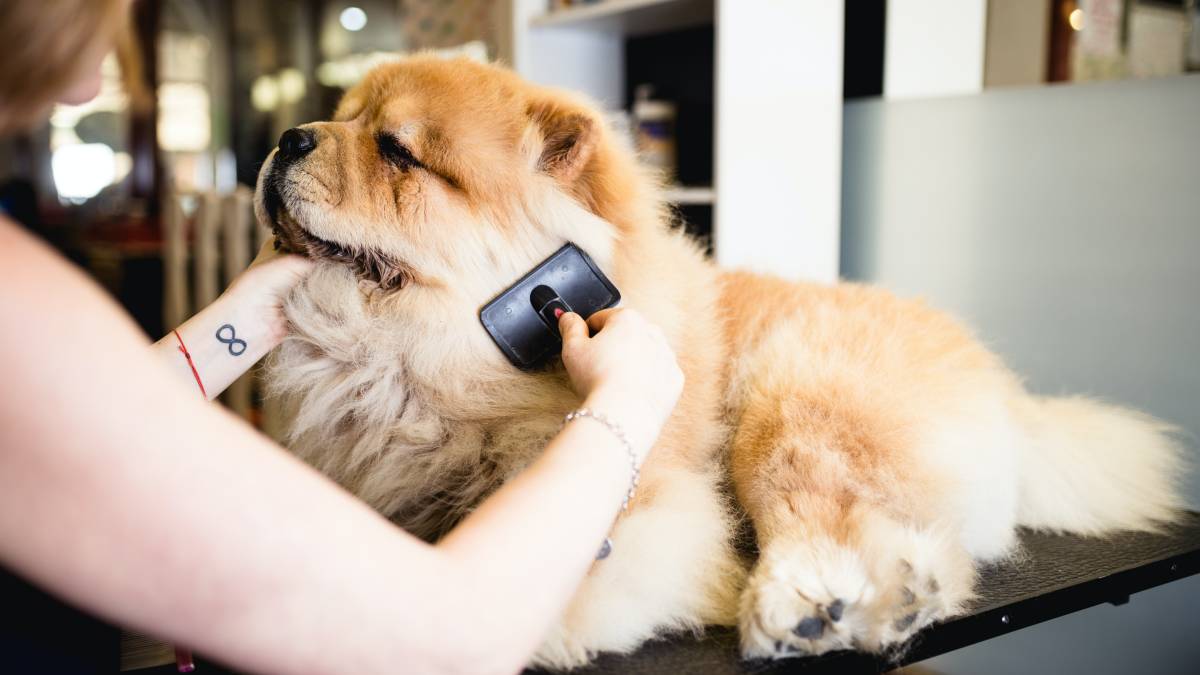- Home/
- Guides/
- Dog Grooming/
- How to Groom a Dog at Home
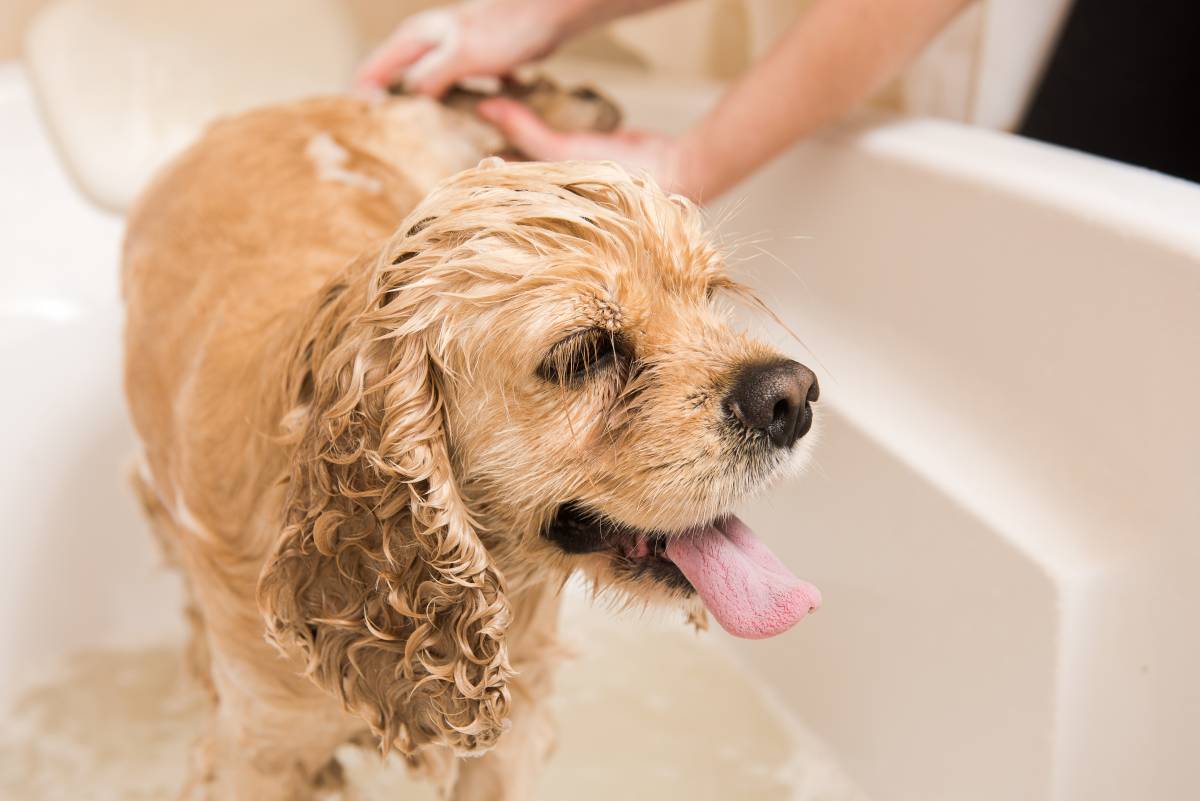
How to groom a dog at home
Groom your dog like a pro with the right tools and safety tips.
Consult a professional groomerLast Updated on
Dogs are endlessly cute and loveable. But with great cuteness comes great responsibility. We’re talking about constant grooming to manage long nails, matted fur, and that fantastic dog breath.
DIY dog grooming at home is the most practical solution for these routine tasks. With these practical tips and tools, you can save the professional grooming appointments for special occasions and more complex tasks.
Tools to groom your dog at home
An electric clipper: A No. 10 Oster blade is great for summer haircuts and trimming fur inside the ears and under the hind legs.
Nail clippers: Have some styptic powder on-hand in case you make a mistake and need to stop any bleeding.
-
Dog comb:
A medium-toothed comb should suit any kind of fur.
A fine-toothed comb is great for thin-haired dogs. You can opt for a flea comb to remove both fleas and tangles.
A wide-toothed comb is great for dogs with thicker fur.
A brush: A slicker or curry brush is best for short hair, and a pin brush will suit long coats.
pH-balanced dog shampoo and conditioner: Avoid using human shampoo as this can irritate your dog’s skin. You’ll also want plenty of old towels post-bath for the inevitable water shake!
Dog ear cleaning solution, forceps, and gauze: These tools will help you clean your dog’s ears.
A dog toothbrush and toothpaste: The most challenging part of cleaning, but also the most important as dog breath is, well, truly intense!
| Learn more: Complete guide to dog grooming tools |
How to groom a dog step by step
Step 1: Trim your dog’s nails

Trim your dog’s nails every three to four weeks, or as needed. Long nails can break or curl back into their paws, which can be painful or even cause infection.
These tips will help you keep your dog’s nails in good condition:
- Trim only a small amount off the tip.
- Talk to your vet first and have them show you how to trim your dog’s nails safely and avoid bleeding and pain. Your vet will let you know a suitable length and the best clipper to use.
- If your dog has transparent nails, trim before the pinkish area, which is the blood vessel. For dogs with opaque dark nails, you will absolutely require guidance from your vet.
- Use a nail file to smooth rough edges.
Step 2: Brush your dog’s fur
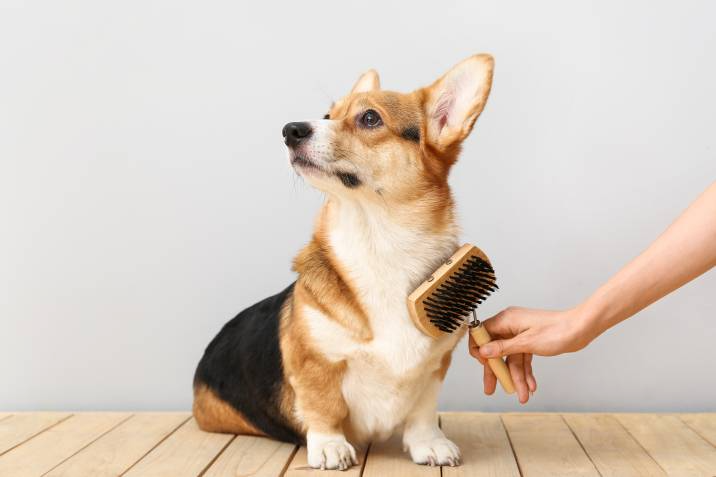
Before bathing your dog, brush their fur to remove loose fur and debris. This is also the best time to untangle mats, as it’ll be harder when the fur is wet.
Choosing the proper brush is also essential. Different types of dogs require different brushes, so choose a comfortable brush suitable to your dog’s fur type. When done right, brushing can be an enjoyable session for your dog.
Watch your dog’s reactions and decrease the pressure applied if they seem uncomfortable. You can also use a grooming glove or soft brush for short hair breeds.
Step 3: Bathe your dog
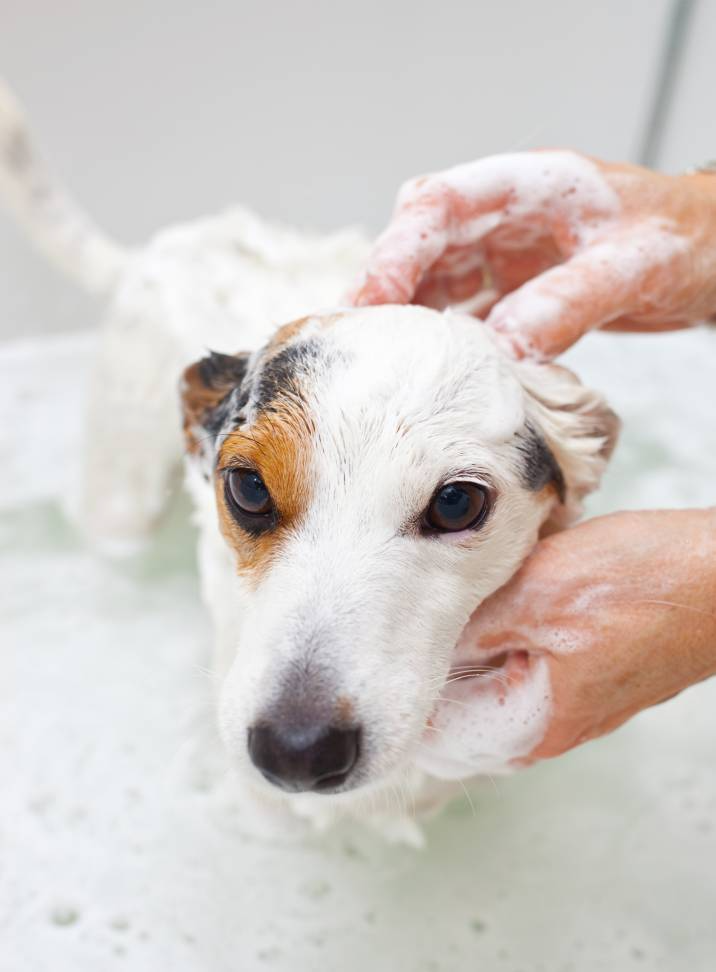
If you teach your dog to associate bathing with things they love (like treats), you’ll be in for a much easier experience. Help your dog feel relaxed and comfortable and approach bathing gradually and calmly. Give lots of praise and rewards along the way, and consider the following tips:
- Brush and trim mats or knots before bath time.
- Wet your dog’s hair to the skin and work from the chest and neck area down.
- Avoid wetting the head, and make sure you avoid the eyes, ears, nose, and mouth. Use a damp face cloth to clean the head.
- Prevent water from getting into the ears.
- Once wet, apply hypoallergenic dog shampoo to the chest, then gradually to other areas of the body (ensure you get the undercoat).
- After shampooing, gently rinse off the shampoo thoroughly.
- Apply a gentle, hypoallergenic conditioner, as you did with the shampoo, and let it sit for several minutes before rinsing.
Dry your dog thoroughly and reward them for calm behaviour (throw in a treat at the beginning and end as well). This will help teach your dog that bath time making is a fun and positive experience!
Step 4: Trim or clip the dog’s fur
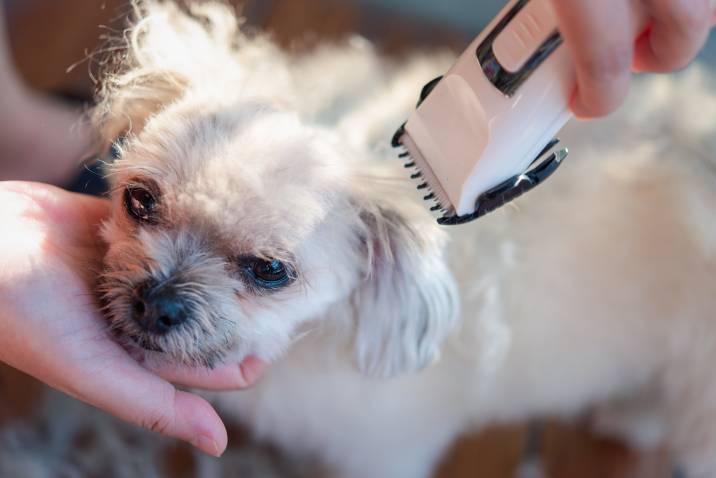
Clip your dog’s fur with the direction of the hair growth for a smooth and even cut. Before attempting to clip your dog’s fur, it’s best to call in a professional groomer to walk you through the process. This way, you can learn the proper technique, combs, and blades suitable for your dog’s coat type.
Extra tip: Go slow and keep your clippers sharp, so you can easily cut hair without tugging your dog’s hair.
Step 5: Clean the dog’s ears

Regular ear cleaning is not necessary for all dogs unless they have long, droopy ears. If your dog’s ears do require a clean, you can follow these three simple steps (but if you’re uncomfortable doing this yourself, you can leave it to a professional):
- Gently hold your dog’s head and expose the open ear.
- Apply dog ear cleaning solution.
- Use a sterile gauze pad or sponge to wipe the excess solution gently.
Head shaking, ear discharge, ear scratching, or rubbing are some signs that your dog may have an issue with its ears. Take your dog to the vet to confirm this.
Step 6: Brush your dog’s teeth
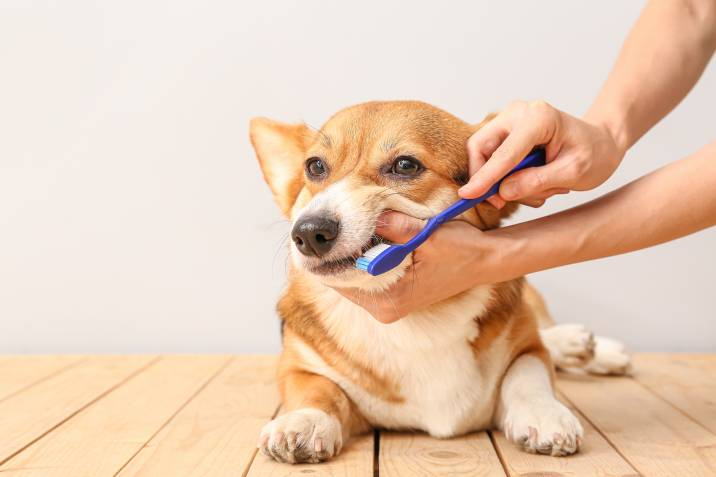
By giving your dog safe chew items daily, you can do most of the heavy lifting in keeping their teeth and gums healthy. Dental chews are your best friend!
When it comes to brushing their teeth, follow these steps:
- Squeeze doggie toothpaste onto the brush and let your dog lick it off.
- Flip your dog’s lips and gently rub the toothpaste against the teeth and gums with a dog toothbrush.
- No matter how long this task takes, give your dog a treat afterwards! This will help teach them that brushing equals rewards.
| Also read: Your Ultimate Guide to Dog Care – Everything you need to know about caring for a dog, from grooming to training |
Hiring a dog groomer
Getting comfortable with grooming your dog can take some time, but you can consult a professional groomer and learn the basics fast and with more confidence. Or you can check our dog grooming price guide and book a dog grooming service.
Save yourself some time and ensure the safety of your pet by letting a professional give them a fresh new look today.
FAQs on grooming a dog
Dog grooming can take an hour on average or two hours for larger breeds and more difficult coats. Meanwhile, small, short-haired breeds can be groomed in as little as 20 minutes. The size of your dog and the condition of their fur will be the determining factor in the time it takes to groom them.
As a general rule, only bathe your pet when necessary. Visible dirt or an evident smell are usually good signs that it may be bath time, as are lots of mats and tangles in the fur. How often to bathe your dog will vary depending on the dog’s breed and fur type. For example, a long-haired dog prone to mats may need more regular grooming. But for short-haired breeds, frequent bathing can dry out a dog’s skin and hair.
Short-haired dogs generally require less grooming than medium and long-haired coats. Look for any tangles or mats and follow this general guide:
- Short-coated dogs: Brush once every few weeks
- Short but dense fur: Brush once a week or fortnightly
- Long-coat or double-coat: Brush every week
Placing a towel over a dog’s eyes or head is one way to calm a dog while you trim their nails. You can also try tools like quiet clippers or a grooming hammock. As a general tip, keep your movements gentle and reward your dog with treats. In time, your dog may learn to feel more at ease with grooming. Do keep in mind that every dog is different, and you may need to try different methods to keep your dog still during grooming. A dog groomer can give you advice specific to your situation.
Find dog groomers, fast
Find a Dog Groomer
Related articles

How to groom a dog at home
Read more

How often should you wash your dog
Read more

Simple steps to wash your dog
Read more
Related price guides
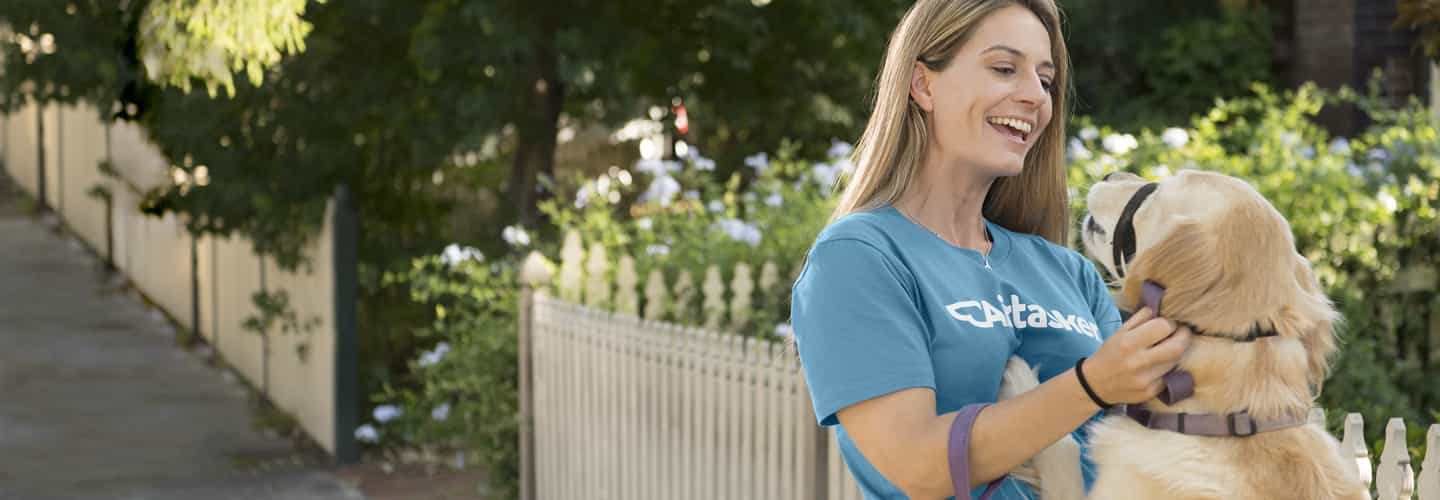
How much does a dog walker cost?
Read more
